Special Report
This Is the Oldest Bridge in the World
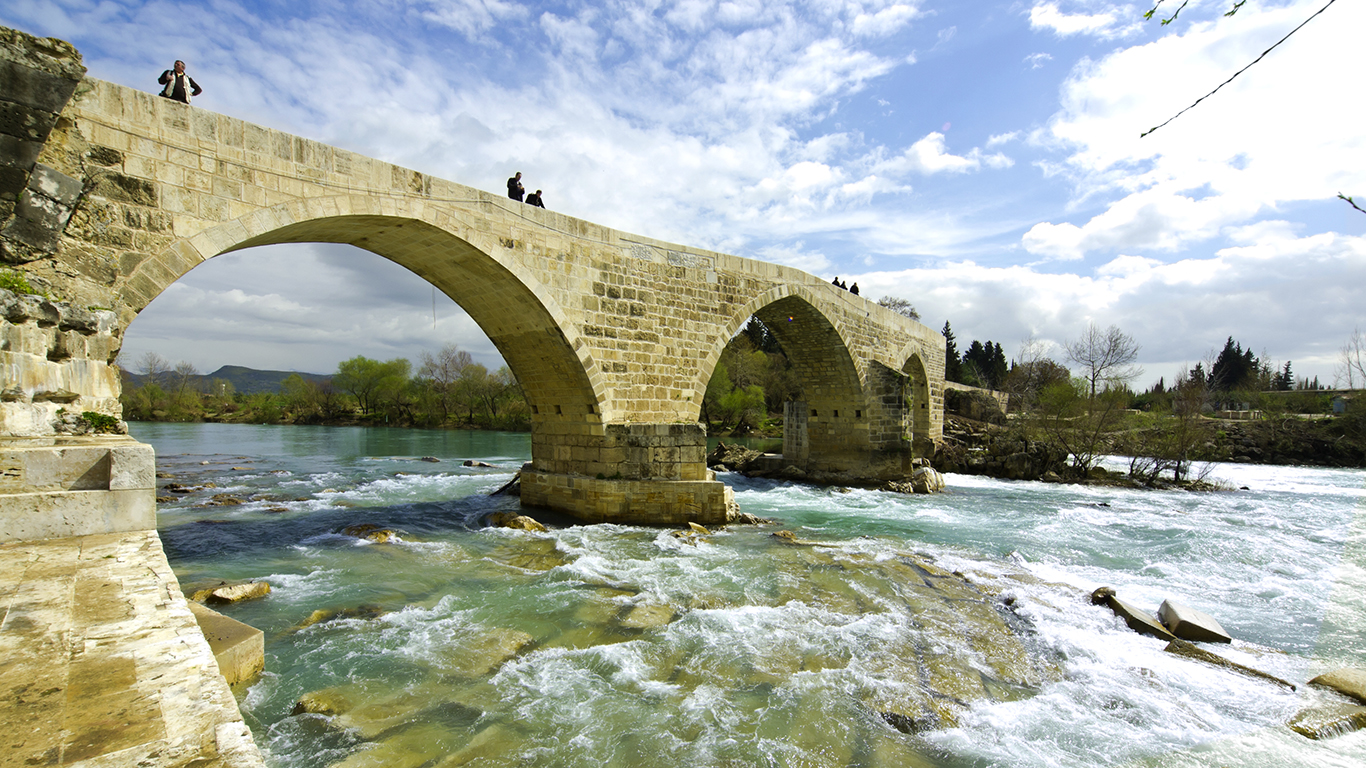
Published:

The world is full of highways and roads that cross over rivers or valleys. For centuries, they have been made passable by bridges, and the oldest bridge in the world is Arkadiko Bridge in Argolis, Greece.
There are tens of thousands of bridges in America too, from 17th century ones in New England to colossal ones like the Golden Gate Bridge. As is true with most things, American bridges are new by global and historic measures. (These are the most dangerous bridges in every state.)
When people began building bridges, civilization took a giant leap forward. The construction of bridges represented mobility, increased awareness of other cultures, and offered commercial opportunity. Bridges helped make possible mega-cities in the ancient world in China and the Roman Empire.
The oldest bridges are marvels because of their use of local materials, curved arches and sophisticated engineering techniques, and also the fact that they have borne witness to so much history. Unfortunately, others have been lost to natural disasters, such as floods and some of the worst earthquakes of all time, or to wars.
24/7 Tempo has compiled a list of the oldest bridges still in use. Some bridges that are hundreds of years old are actually newer versions of even older structures that span gorges, estuaries, inlets, and rivers. Virtually all of the bridges on the list are well known and have had some kind of reconstruction work.
The oldest bridges are found in China and areas of the former Roman Empire, such as Turkey, Greece, and Spain. You will not find any bridges from the United States on the list. The oldest bridge in the United States is the Frankford Avenue Bridge, also known by other names, which was erected in 1697 in northeast Philadelphia. (Bridges aside, this state has the best highways in America.)
The oldest bridge in the world, the Arkadiko Bridge, was built more than 3,000 years ago during the Bronze Age by Mycenaean Greeks. This ancient 72-feet bridge is still used by modern Greeks. The arch bridge is an impressive feat of engineering, as it does not use any binding agent to hold itself together.
Click here to read about the oldest bridges in the world
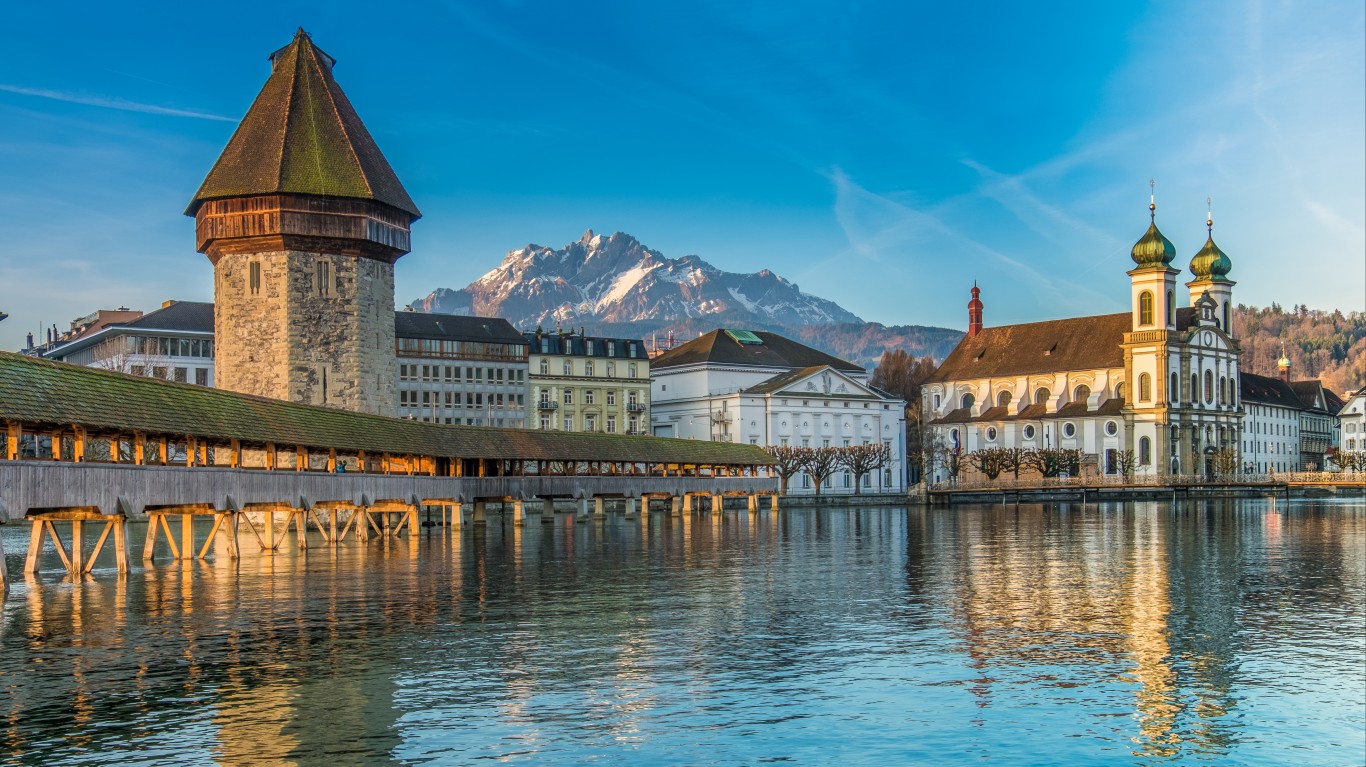
20. Kapellbrücke
> When built: 1333
> Location: Lucerne, Switzerland
> Who built it: Lucerne town fathers
> Length: 557 feet
Kapellbrücke or Chapel Bridge, is a wooden pedestrian bridge that spans the Reuss River in Lucerne in Switzerland and is one of the most visited tourist sites in the country. The bridge was built in 1333 and is named after the nearby St. Peter’s Chapel. A noteworthy feature is the octagonal water tower, whose gabled roof was rebuilt after a fire in 1993. The bridge also features roof panels depicting important events in Swiss history and mythology.
[in-text-ad]

19. Alte Nahebrücke
> When built: 1300
> Location: Bad Kreuznach, Germany
> Who built it: Simon II, Count of Sponheim-Kreuznach
> Length: 442 feet
Alte Nahebrücke is a stone bridge built around 1300 by Simon II, Count of Sponheim-Kreuznach, who controlled the town of Bad Kreuznach. The structure was built to replace a wooden bridge that linked housing settlements on each side of the Nahe River. The bridge became an important link on the road between Mainz and Trier. The bridge also formed part of the fortifications for the town.
18. The Lugou Bridge (Marco Polo Bridge)
> When built: 1192
> Location: Hai River, China
> Who built it: Unknown
> Length: 872 feet
The Lugou Bridge is one of the four renowned ancient bridges in China, along with the Zhaozhou Bridge, the Floating Guangji Bridge, and the Luoyang Bridge. It is also known as the Marco Polo Bridge because the famed Italian explorer praised it when he visited China. The solid granite span is known for its lion sculptures and other art objects on the pillars of the bridge, which is supported by 11 piers. It was at this bridge that the Japanese attacked a Chinese garrison that started the Sino-Japanese war in 1937.
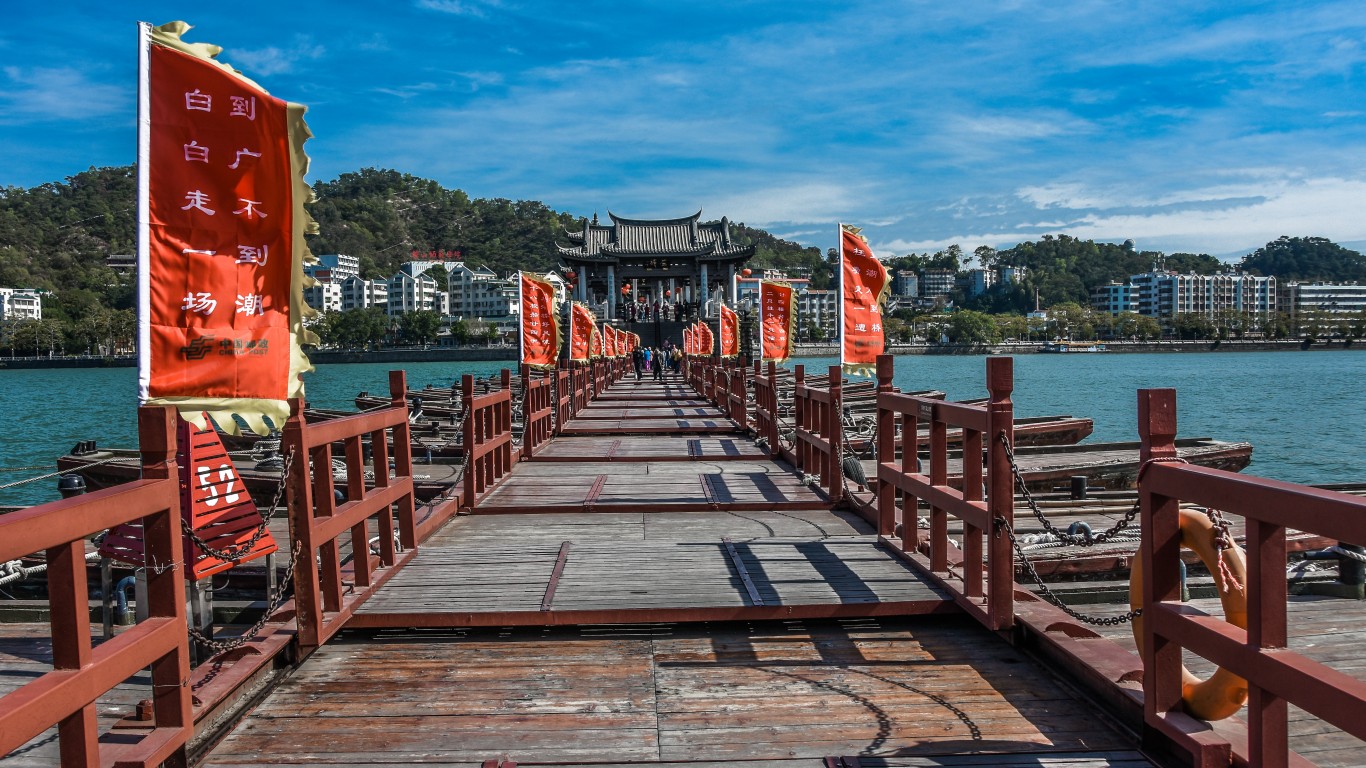
17. Floating Guangji Bridge
> When built: 1206
> Location: Chaozhou, Guangdong province, China
> Who built it: Ming Dynasty engineers
> Length: 1,640 feet
Guangji Bridge is also known as Xiangzi Bridge and it spans the Han River in Chaozhou, Guangdong Province, China. The bridge is known as one of the four ancient bridges of China, along with the Zhaozhou Bridge, the Lugou Bridge and the Luoyang Bridge. What sets Guangji Bridge apart is that it is the world’s first pontoon bridge that opens and closes. Eighteen floating boats support the span, which separates to allow ships and boats to pass. Originally, the entire bridge was a floating structure supported by 86 boats. Today, only the middle section opens.
[in-text-ad-2]
16. Anping Bridge
> When built: 1151
> Location: Quanzhou, Fujian, China
> Who built it: Shaoxing reign in Southern Song Dynasty
> Length: 1.26 miles
Anping Bridge, in Quanzhou, Fujian, China, is built of massive stone blocks. The bridge has 331 spans of granite beams resting on top of stone piers. The largest beam weighs 25 tons. At more than 1.26 miles, it had been the longest bridge in China until 1905. Over time, the shifting silt of the estuary of the Shijing River has reduced the bridge’s length by 150 feet. The bridge is a nationally protected historic site and areas around it are being developed into parks.
15. Luoyang Bridge
> When built: 1059
> Location: Luoyang River, China
> Who built it: Emperor Xuanzong
> Length: 3,940 feet
Luoyang Bridge, another of the four famous ancient bridges in China, crosses over the Luoyang River where it meets the sea. Emperor Xuanzong named the bridge after Luoyang City, which is not near the bridge, because the landscape reminded him of Luoyang City, a former dynastic capital. It took six years to complete the original 3,940-foot granite span in 1059. The bridge has 44 piers, 104 stone lions, and seven stone towers. Chinese engineers thought of an ingenious method to reinforce the bridge’s foundation. The Chinese used the liquid secreted from oysters as a bonding agent for the piers and the footstones.
[in-text-ad]
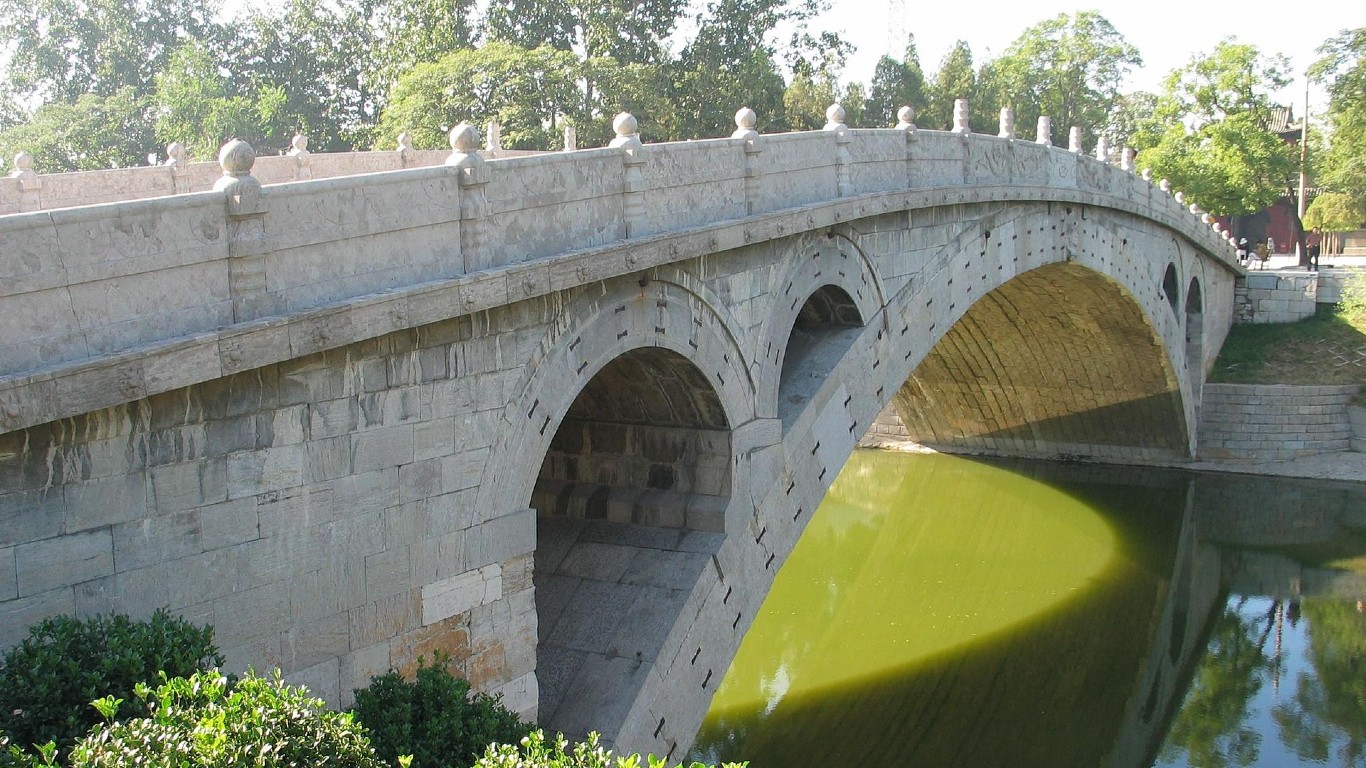
14. Anji Bridge (Zhaozhou Bridge)
> When built: 605
> Location: Zhaoxian, Shijiazhuang, Hebei, China
> Who built it: Li Chun
> Length: 167 feet
Anji Bridge, or Zhaozhou Bridge, is another of the four famous ancient Chinese bridges. Anji translates to “safe crossing.” The span crosses the Xiao River and is China’s oldest standing bridge, as well as the world’s oldest open-spandrel arch bridge. The bridge was built during the Sui dynasty by architect and stonemason Li Chun. The bridge is constructed with 28 curved limestone slabs. The bridge’s four spandrels have allowed the span to effectively manage the stress of flooding.

13. Eurymedon Bridge
> When built: Late 4th century
> Location: Near Siege, Pisidia, Turkey
> Who built it: Roman empire
> Length: 853 feet
Called Oluk Köprü today, this span is located over the Köprülü Canyon in Turkey. The bridge stands over the Köprüçay River, which was called Eurymedon in ancient times. The span remains as a key link between the Mediterranean coast and the interior of Turkey. The span is just 11 feet wide, placing limitations on vehicles that can cross it. Much of the bridge was destroyed in an earthquake, and in the 13th century, Sultan Alâeddin Keykûbad ordered that a new bridge be built on the remains of the ancient Roman structure.

12. Dezful Bridge
> When built: 260
> Location: Dezful, Iran
> Who built it: Persian empire, Sassanid King Shapur I the Great
> Length: 1,345 feet
The Dezful Bridge in southern Iran, built by 70,000 Roman prisoners of war, is one of the iconic landmarks in the Middle Eastern nation. The Romans became prisoners after the Sassanid King Shapur I the Great defeated them at the Battle of Edessa in 260 AD in Turkey. The monarch knew of the Romans’ building prowess, and put them to work on many projects in his kingdom, including the construction of the Dezful Bridge. The span is comprised of stone, mortar and baked clay and has 14 original arches. The Dezful Bridge is under consideration as a UNESCO World Heritage Site.
[in-text-ad-2]
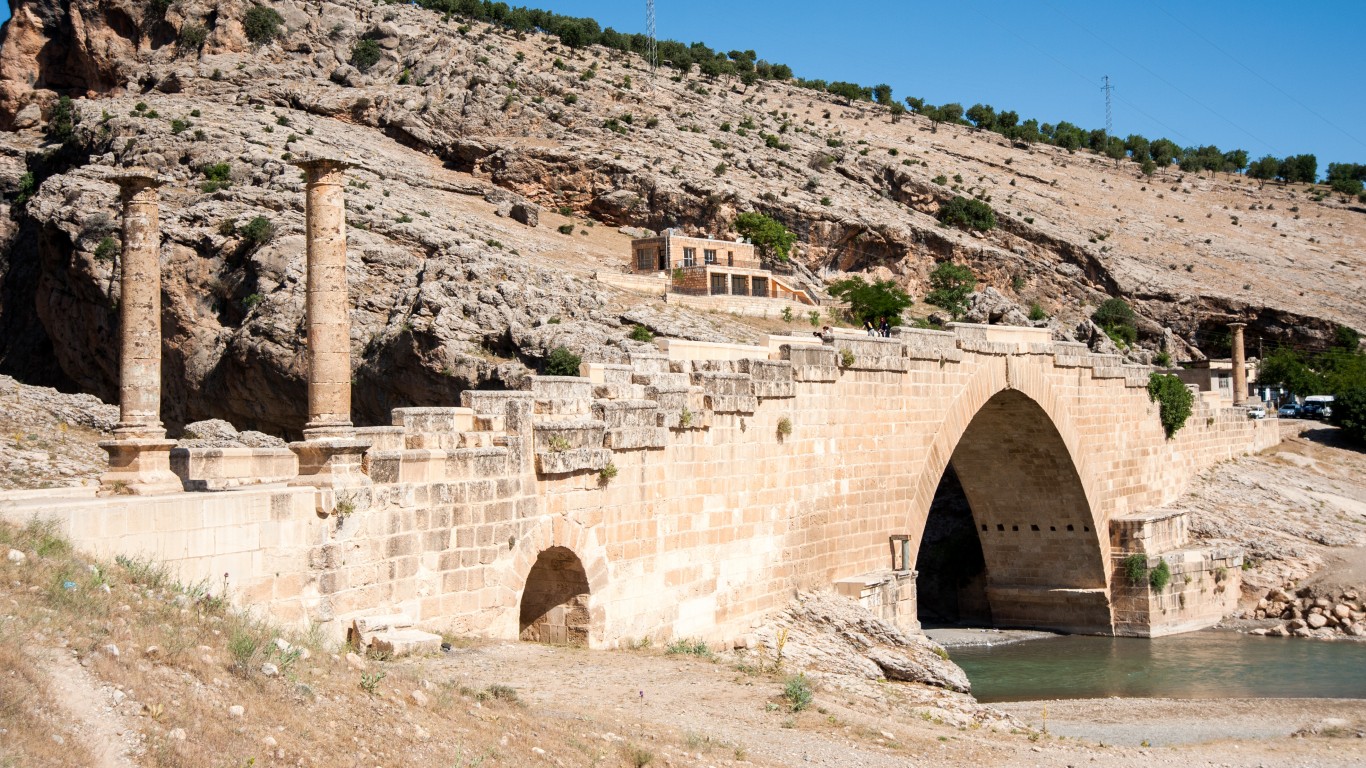
11. Cendere Bridge
> When built: c. 200
> Location: Adiyaman Province, Turkey
> Who built it: Roman empire
> Length: 394 feet
The Cendere Bridge, also known as Severan Bridge or Septimius Severus Bridge, was built by Romans near the ancient city of Arsameia in southeastern Turkey. Four Corinthian style columns were added to the bridge in honor of Emperor Lucius Septimius Severus, his wife and two sons. The Cendere Bridge is now apart of one of the most important national parks in Turkey, which is a UNESCO World Heritage Site.
10. Penkalas Bridge
> When built: 2nd century
> Location: Aezani, Turkey
> Who built it: Roman empire
> Length: N/A
The Penkalas Bridge is a Roman-built vaulted-arch span over the Penkalas River in the Turkish town of Aezani. The five-span bridge is believed to be one of four ancient bridges in the region and the most important crossing-point because of its proximity to a temple of Zeus, as well as its direct access to a Roman road.
[in-text-ad]

9. Pergamon Bridge
> When built: 2nd century
> Location: Pergamon, Turkey
> Who built it: Roman empire
> Length: 29 feet
Pergamon Bridge is an arch bridge located in Pergamon in Izmir, Turkey. The structure is considered to be a Roman substruction bridge over the Selinus River in what had been the ancient city of Pergamon, now called Bergama. It was constructed during the reign of Emperor Hadrian in the second century. The bridge is more than 640 feet wide and designed to create a passage underneath a court in front of a massive temple complex.

8. Ponte Sant’Angelo
> When built: 134
> Location: Rome, Italy
> Who built it: Roman empire, commissioned by Hadrian
> Length: 443 feet
Ponte Sant’Angelo is a pedestrian bridge and one of the most famous bridges in Rome. The structure was commissioned by Emperor Hadrian to traverse the Tiber River from the city center in Rome to his mausoleum, now known as the Castel Sant’Angelo. The name Sant’Angelo, or holy angel, comes from the belief that the archangel Michael appeared on top of the mausoleum and ended a plague in Rome. In the 17th century, famed sculptor Lorenzo Bernini added 10 physical angels to the bridge, each of them holding a symbol related to the crucifixion of Jesus, such as a crown of thorns.
7. Alcántara Bridge
> When built: 104-106
> Location: Alcántara, Spain
> Who built it: Roman empire, by order of Trajan
> Length: 203 feet
Alcántara Bridge in Alcántara, Spain, is another example of Roman engineering prowess. It was constructed under orders from Emperor Trajan, and the stone-arched bridge spans the Tagus River. The six-arch bridge has had to be repaired over time because of damage inflicted by wars with the Moors and the Portuguese.
[in-text-ad-2]

6. Pont du Gard
> When built: Mid-1st century
> Location: Languedoc-Roussillon, France
> Who built it: Roman empire (aqueduct)
> Length: 902 feet
Pont du Gard, one of the world’s most photographed spans, has inspired artists such as French painter Hubert Robert and English artists William Marlow and Frederick Richard Lee. The span was built almost 2,000 years ago over the Gardon River in Languedoc-Roussillon, France. It is an architectural marvel. The three-tiered structure’s stones weigh up to six tons and were cut to precisely fit, eliminating the need for mortar. In 2004, Pont du Gard was named an official Grand Site de France.
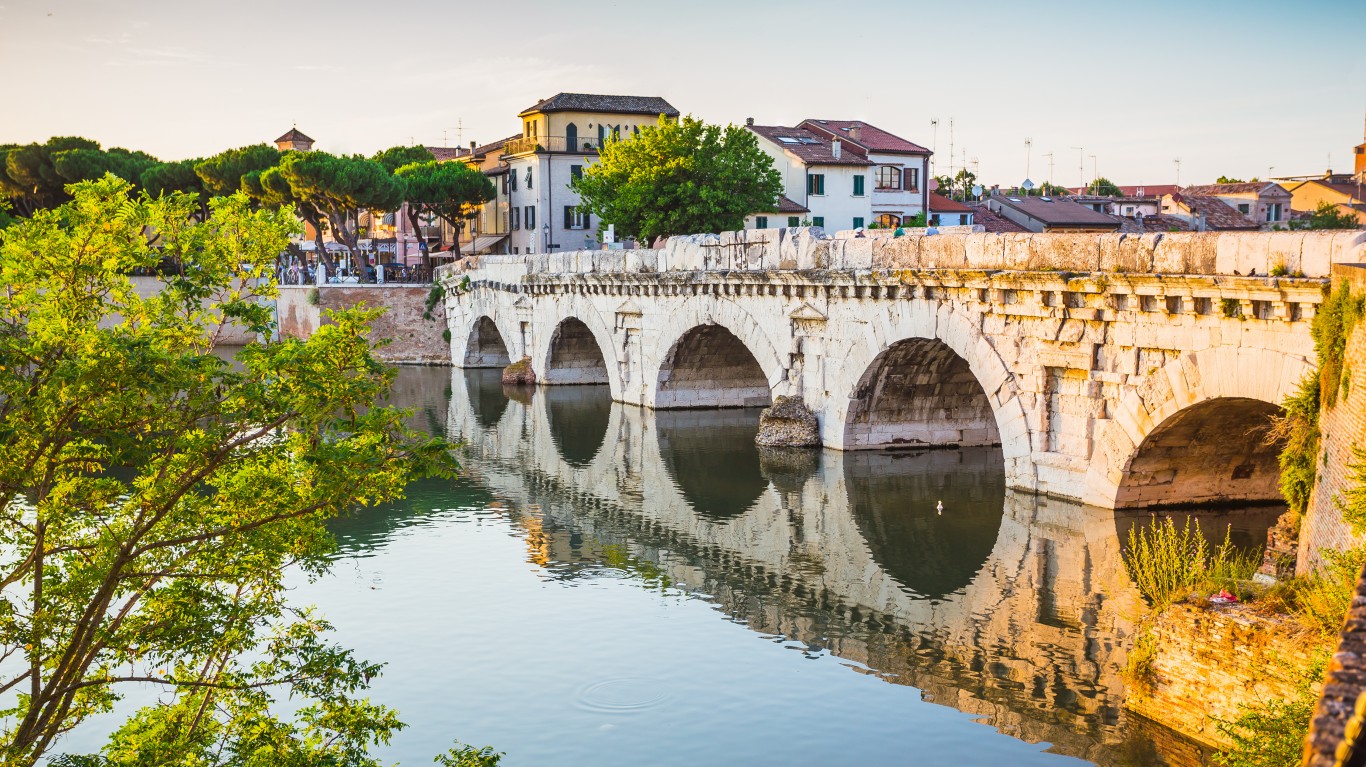
5. Ponte di Tiberio
> When built: 20 AD
> Location: Rimini, Italy
> Who built it: Roman empire
> Length: 30 feet
The bridge in Rimini, Italy, a city located on the Adriatic Sea, was built during the reign of emperors Augustus and Tiberius (after whom the bridge was named) and completed in 20 AD. Despite the passage of time, warfare, and the forces of nature, the bridge remains pretty unchanged since the Roman era. A visitor can still read the original inscriptions to Augustus and Tiberius on the white stone. One factor that won’t erode the bridge is the river. The river Marecchia was diverted away from the bridge in the 20th century.
[in-text-ad]
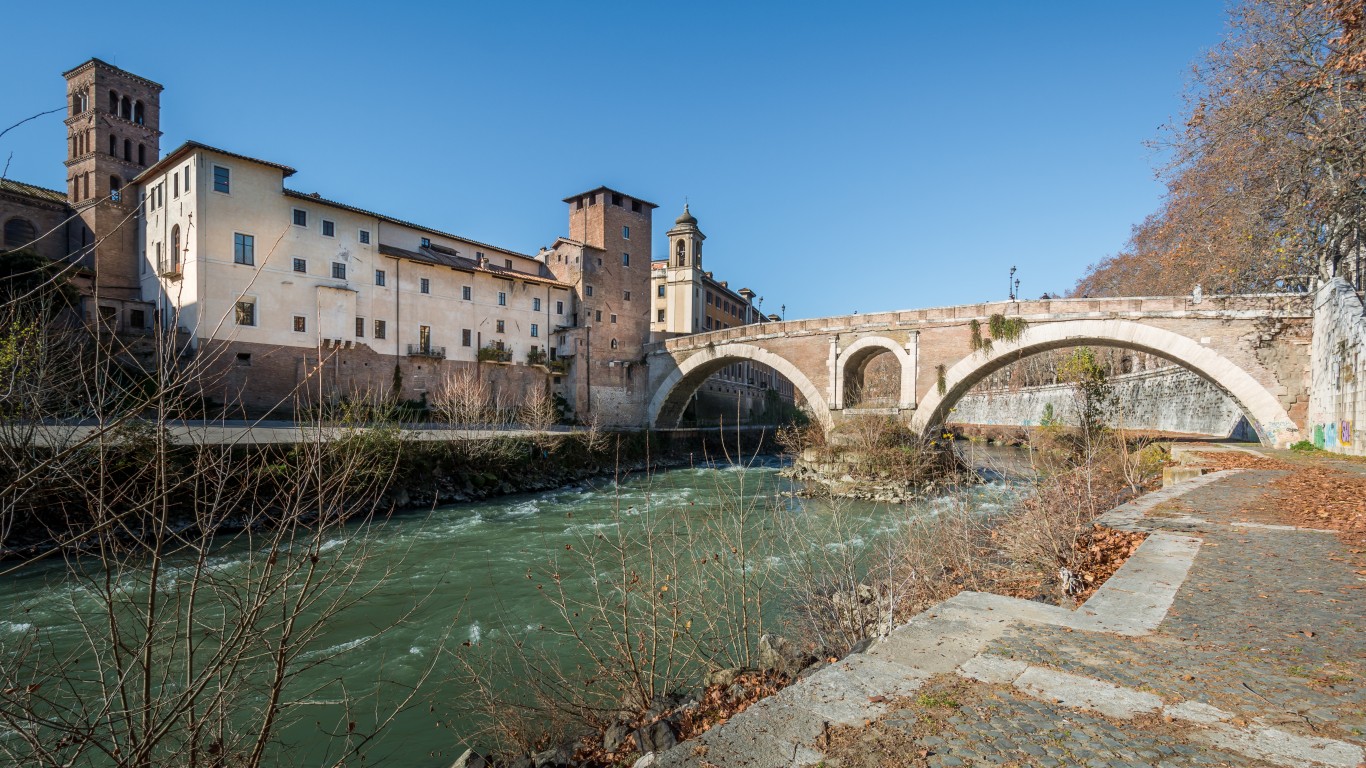
4. Pons Fabricius
> When built: 62 BC
> Location: Rome, Italy
> Who built it: Roman empire
> Length: 203 feet
The Pons Fabricius, also called the Ponte dei Quattro Capi (Four Heads), is the oldest existing Roman bridge in its original state. It was built in 62 B.C. and succeeded an earlier wooden bridge that had burned down. The bridge is named after Lucius Fabricius, the curator of Roman roads. After a flood about 40 years after the bridge’s construction, the Romans made some adjustments to it. One of the adjustments might have been the addition of a small arch on the bridge that relieves pressure from the rising waters on the Tiber River. This might explain the bridge’s longevity.

3. Caravan Bridge
> When built: 850 BC
> Location: Izmir, Turkey
> Who built it: Roman empire
> Length: 902 feet
Many sources, including the Guinness Book of World Records, say the Caravan Bridge over the river Meles is the oldest datable bridge still in use. The Caravan Bridge is an arched stone slab bridge and was built sometime around 850 B.C. in Izmir, Turkey, which is a city on the Aegean Sea. The span operated as an entry point into the city of Izmir, known in antiquity as Smyrna. The river Meles is also known as the birthplace of the Greek author Homer and the river and the bridge were mentioned in his works.

2. The Tarr Steps
> When built: 1000 BC
> Location: Exmoor National Park in Somerset, England
> Who built it: Unknown
> Length: 180 feet
The Tarr Steps are an ancient clapper bridge — a span made completely of rocks resting on top of each other — located across the River Barle in Exmoor National Park in Somerset, England. No one knows for certain when it was built, with some speculating the bridge might have been constructed as early as 1000 BC. Local legend claims the Devil himself built the bridge so he could sun himself on the river. Tarr Steps has remained mostly intact through the ages. But the local folks aren’t taking any chances. They’ve numbered all the stones so they can be recovered and put back in place after flooding.
[in-text-ad-2]
Even if something is ancient it can still be useful. The Mycenaean Bridge at Kazarma was built more than 3,000 years ago during the Bronze Age and is still used by modern Greeks. The arch bridge is an impressive feat of engineering, as it doesn’t use any binding agent to hold itself together. It was also built with curbs, presumably to keep speeding chariots from falling off. Also, the bridge was wider than the roads of the time to accommodate chariots.
Retirement planning doesn’t have to feel overwhelming. The key is finding expert guidance—and SmartAsset’s simple quiz makes it easier than ever for you to connect with a vetted financial advisor.
Here’s how it works:
Why wait? Start building the retirement you’ve always dreamed of. Click here to get started today!
Thank you for reading! Have some feedback for us?
Contact the 24/7 Wall St. editorial team.